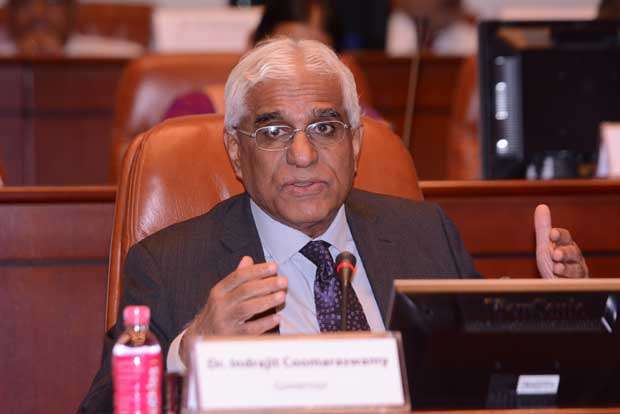05 Apr 2018 - {{hitsCtrl.values.hits}}

By Indika Sakalasooriya
The 25 basis point lending policy rate cut announced yesterday signals the Central Bank moving away from the tightening bias it had maintained for almost two years, Central Bank Governor Dr. Indrajit Coomaraswamy said.
Benign inflation, slower private credit growth, higher exports and lacklustre GDP growth were cited as key reasons for the rate cut, which caught market by surprise, as most of the surveys on policy rate direction forecast the Central Bank to keep the rates unchanged.
Accordingly, the Monetary Board of the Central Bank reduced the Standing Deposit Facility Rate (SDFR) by 25 basis points to 8.50 percent and kept the Standing Deposit Facility Rate (SDFR) unchanged at 7.25 percent. The Statutory Reserve Ratio (SRR) was also kept unchanged at 7.50 percent.
“The Monetary Board felt it would be timely at this juncture to give a signal that the tightening phase of the monetary policy should come to an end and that is the signal that we are keen to deliver,” Dr. Coomaraswamy told reporters in Colombo, yesterday, following the release of the second monetary policy review for this year.
He said the situation has improved “quite significantly” from the last quarter of 2017, where the headline inflation peaked due to supply disruption.
“The headline inflation is now within the 4 to 6 percent band. Core inflation is also within the band and we have seen that inflation expectations are fairly firmly anchored now. Our expectation is that the inflation would remain in the bottom half of the inflation band throughout the rest of the year,” he said. He noted that even if there are adjustments to administered prices, including the introduction of a pricing formula for fuel, the inflation may remain well within the target band of 4 to 6 percent.
The International Monetary Fund last month asked the Central Bank to stand ready to tighten monetary policy if signs of demand-side inflation pressures or accelerating credit growth appear.
Meanwhile, in the monetary sector, in spite of the increase in credit to the public sector by banks, the growth of both broad money supply and credit extended to the private sector remained subdued during the first two months of 2018.
The private sector credit growth decelerated to 14.6 percent year-on-year in February 2018 from 15.2 percent in January 2018 and 14.7 percent in December 2017.
Notable improvements were also observed in the country’s fiscal front with better tax revenue collection helping the government to record a primary surplus and a moderation in the debt to GDP ratio in 2017. The budget deficit nevertheless overshot to 5.5 percent, from the initial target of 4.6 percent.
However, despite these positive macroeconomic developments, Sri Lanka’s GDP growth hit a 16-year low in 2017. The economy was estimated to have grown 3.1 percent amid adverse weather condition that affected the agriculture sector. The services sector also showed a slight slowdown.
With the Central Bank moving away from the tightening bias, Dr. Coomaraswamy expects the economic growth to pick up “a shade below 5 percent”, this year. However, he did not fail to sound a cautionary note on the present volatile local politics that could upset the fiscal front.
“If there is any significant fiscal slippage, we will have to change the whole equation,” he said. Sri Lanka’s political climate has become toxic with the main two parties of the collation government receiving a drubbing at the local government polls held this February with the Rajapaksa-backed new political party emerging victorious.
The Central Bank is currently maintaining “radio silence” over the proposed sovereign bond up to US $ 2 billion, Dr. Coomaraswamy said.
“At the right time, we will go to the market,” he told journalists yesterday.
In January, the Central Bank advertised for lead mangers/book runners to manage the proposed sovereign bond issuance. According to the Central Bank, the dollar-denominated bond issue could be in single or multiple tranches with a fixed coupon and medium to long-term maturities.
The Central Bank had indicated that it may raise most of its foreign financing in the first half of 2018 taking advantage of an excess liquidity in global markets and before the interest increases by the US Federal Reserve.
Dr. Coomaraswamy expects at least three policy rate increases by the Fed this year.
The Finance Ministry recently announced plans to raise US $ 1 billion through a foreign currency term financing facility.
18 Nov 2024 6 hours ago
18 Nov 2024 7 hours ago
18 Nov 2024 7 hours ago
18 Nov 2024 8 hours ago
18 Nov 2024 18 Nov 2024